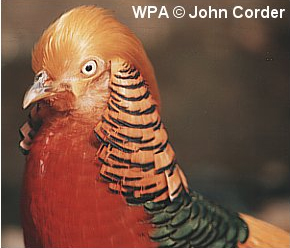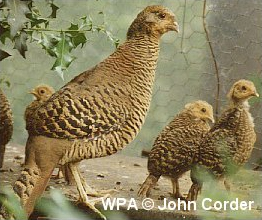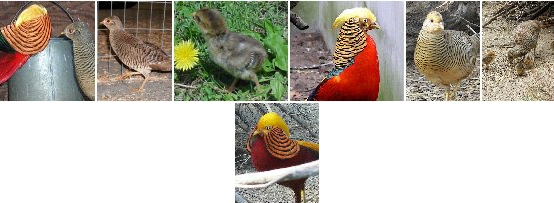 The Golden Pheasant is one of the most popular of all pheasant species kept in captivity. It is very beautiful, hardy, easy to keep and great for beginners. The Golden has been kept in captivity since as early as 1740 and perhaps was the first type of pheasant brought to North America. There is evidence that George Washington may have kept them at Mt. Vernon! For being so well known and familiar in captivity, very little is known of their habits in the wild, in the mountains of central China.
The Golden Pheasant is one of the most popular of all pheasant species kept in captivity. It is very beautiful, hardy, easy to keep and great for beginners. The Golden has been kept in captivity since as early as 1740 and perhaps was the first type of pheasant brought to North America. There is evidence that George Washington may have kept them at Mt. Vernon! For being so well known and familiar in captivity, very little is known of their habits in the wild, in the mountains of central China.
This species, along with the Lady Amherst Pheasant (C. amherstiae), make up the group of pheasants called the Ruffed Pheasants, genus Chrysolophus. They are named for their cape or ruff which they spread around their face and neck during courtship. Since these two species are so closely related, many breeders have crossed them, making “pure” Goldens and Amhersts hard to find in captivity.
The wild form of the Golden is often called the Red Golden in captivity, and the males are one of the most brilliantly colored of all birds. The adult males should have a full, silky golden-yellow crest with perhaps a slight tinge of red at the tip. The face, throat, chin and the sides of the neck are rusty tan; the wattles and orbital skin are yellow. The ruff or cape is a pale fulvous to a light orange, with each feather with a bluish-black border. The upper back is green and the rest of the back and rump is a golden-yellow. The breast is scarlet; the flanks and underparts are scarlet changing into a light chestnut. The tertiaries of the wing are blue and the scapulars are dark red. The central tail feathers are black, spotted with cinnamon and the tip of the tail cinnamon buff. The upper tail coverts are the same color as the central tail feathers. Immature males resemble hens, but will have a spotted tail and varied patches of red throughout the plumage.
The hen, as in most pheasants, has a much duller coloration than the male. At first site, she is an overall rufous brown with dark barring and a buff face and throat. The breast and sides are a barred buff and blackish brown. Her abdomen is a plain buff which varies from hen to hen. Both sexes have yellow legs and bill.
When purchasing adult goldens, please observe the adult male for signs of Amherst blood. The male will have the following if crossed: 1.) Any trace of red in the crest besides that at the very tip, 2.) Any traces of green in the breast, 3.) Red in the lower back or rump, 4.) Large size, 5.) Legs dark. A Golden hen should be small, also with yellow legs and no tinge of red in the crown. Immature goldens are much lighter in the overall color when compared to an Amherst, and of course, the legs will be yellow.
 Mutations: Being an avicultural subject for so long, there is no doubt that several mutations have been developed over the years. I have serious doubt of several of the new mutations (believe many were used by crossing with Amherst) and have only included a few brief descriptions of the mutations that have been established for several years. One mutation, the Yellow Golden, is almost as common as the wild Golden in aviculture and I have provided a link with more information.
Mutations: Being an avicultural subject for so long, there is no doubt that several mutations have been developed over the years. I have serious doubt of several of the new mutations (believe many were used by crossing with Amherst) and have only included a few brief descriptions of the mutations that have been established for several years. One mutation, the Yellow Golden, is almost as common as the wild Golden in aviculture and I have provided a link with more information.
The Dark-throated Golden was the first mutation developed from the golden pheasant, however, there is recent information that disputes validity of this being a pure mutation. This dark bird was first seen in the 1860s. The adult male resembles a normal golden, but is darker with a smoky-black face and throat. The tail is also barred and not spotted as in the normal form. The hen is easily distinguishable from a normal hen. She is much darker all around with dark barring. The chicks differ from normal goldens in being dark brown with white spots. There are many indications that these birds could in fact be derived from Amherst crossings.
The Yellow Golden, also known as the Ghigi golden, was developed around the middle of this century by the Late Professor A. Ghigi of Bologna, Italy. see provided link for more information
Another mutation, the Cinnamon Golden was developed by William Petzold of Conecticut in the early seventies. The adult male is similar to the normal form, and at first glance, many believe that it is, but they have lost the metallic green on it’s back and the blue on it’s wings. Both have been replaced with a glossy gray. The ruff, crest and rump appear a darker yellow – almost orange. The cinnamon generally appears more glossy in appearance than the normal golden. The hens are readily distinguishable from other mutations by being an overall reddish cinnamon color with dark barring. Over the past several years, this mutation has gained in popularity and is now quite common in aviaries. As in the other brightly colored mutations, the male cinnamon golden’s plumage will fade in direct sunlight.
I would like to stress that the mentioned birds, with the possibility regarding the dark-throat, are mutations of the true golden pheasant and NOT hybrids with the Amherst. Since these birds are so closely related, they will cross with the offspring being fertile. There are endless color combinations in these hybrids, but are useless to aviculturists who want to keep pure species, the way nature intended them. Therefore, I would not recommend crossing these two, or any species, of pheasants just to see “what comes out”. In the past year, I was e-mailed photos of hybrids that one person was claiming were “White-ruffed Golden Pheasants”. Just be careful when dealing with someone who claims to have new mutations. Request photos and as much informaiton regarding their development as possible.



